by Lisa Cooke | Sep 22, 2019 | 01 What's New, French |
Filae’s French collection opens the door for non-French-speaking people to discover their family stories online.
40 million people in the world (excluding France) claim French descent. Here’s the latest press release from Filae:

Paris, France – September, 18, 2019 – Filae.com, the world’s largest online resource for accessing French official records, today announced the launch of its first foreign language international sister-site: https://en.filae.com
With more than 40 million people in the world claiming French heritage, the launch of an English language version of Filae.com gives all of them an unprecedented and exclusive access to more than 150 million images of French Census and Vital records (birth, marriage, death) which have been indexed by Filae.com.
As Elvis Presley, Alec Baldwin, Angelina Jolie, Jessica Alba, Kurt Cobain, Warren Buffett, and many other celebrities, 4% of the US population, 17% of Argentinians and 14% of Canadians have French roots!
“The launch of Filae.com is just the beginning of a more global strategy whose aim is to facilitate access to the largest resource of French records and to help people with French descent tracing back their ancestry whatever their language is and wherever they live! We are thrilled to share information we digitized and indexed with family history fans all over the world.” said Toussaint Roze, CEO and founder of Filae.com.
Starting as early as 1500, Filae’s French historical collection features records such as:
- Parish registers,
- Civil records,
- Census and vital records,
- Passenger lists,
- Military records (Napoleonic wars, WWI, WWII),
- Indexes provided by French societies,
- Directories
- and many other historical records (French revolution, etc.)
Filae.com also provides its users with easy-to-use tools to build their own trees or import their gedcom files, upload photos and documents and share them with other members.
Here’s a look at the Filae website:
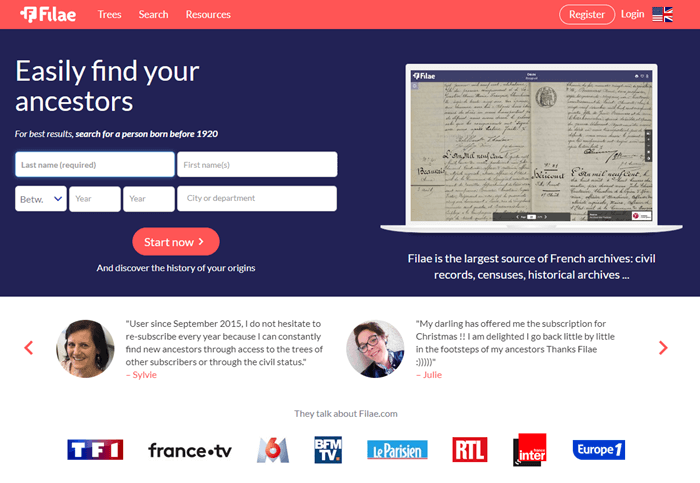
About Filae.com
Launched in December 2016, Filae.com is the first and largest resource for French digitized and indexed records online.
The service was created by Toussaint Roze, a French serial- entrepreneur dedicated to genealogy who previously created successful online services like notrefamille.com, genealogie.com and gedlink.
Filae.com hosts and indexes more than 150 million digitisations of French original records for the XVIIIth and XIXth centuries.
by Lisa Cooke | Jun 17, 2012 |
The Genealogy Gems Podcast Episodes
2011 – 2012 Season Seven
Episode 121
Part 2 of Lisa’s interview with Steve Luxenberg, author of the book Annie’s Ghosts
Episode 122
Find out what a Forensic Genealogist Does. Plus suggestions for “Family Medical History” reading, and how to find “Bonus Content” for Steve Luxenberg’s book Annie’s Ghosts
Episode 123
Taking Genealogy out into the Community. Plus Part 3 of Your Life in 5 Minutes, New Records, and a new name for Grandma.
Episode 124
A new way to search with Google, Photo Mystery, Newspapers with Tom Kemp, plus Part 4 of Your Life in 5 Minutes
Episode 125
Genealogist Shirley Gage Hodges will share her genealogical wisdom with you as well as talk about her status as “perennial student.”
Episode 126
The latest news from RootsTech 2012, my video interview with Nick Barratt, and an in depth look at Find A Grave with the website’s creator, Jim Tipton.
Episode 127
Interview with Historian Nick Barratt of the Who Do You Think You Are? TV series in the UK
Episode 128
WDYTYA Live recap, a Family History Mystery Solved, and an interview with Chris van der Kuyl CEO of brightsolid
Episode 129
Genealogy Gems Book Club: Running Away to Home with author Jennifer Wilson
Episode 130
RootsMagic 5, APG, the 1940 Census…
Episode 131
Defective, Dependent, and Delinquent Census Schedules, and Ancestry acquires Archives.com.
Episode 132
Bonnets and Hats with Maureen Taylor, and the Genealogy Widower
Episode 133
Lisa interviews Henry Louis Gates about his TV series Finding Your Roots.
Episode 134
A Blast from the Past! This episode includes Episodes 1 and 2!
Episode 135
Interview with Linda Chavez of Finding Your Roots
Episode 136
Life After iGoogle! And the brand new Lisa Louise Cooke’s Genealogy Gems website has launched!
Episode 137
Food and Family History with author Gena Philibert Ortega Part 1. Includes a companion video, AND Bonus Video of Gena and Lisa in the kitchen cooking up a Blast from the Past!
Episode 138
Food and Family History with author Gena Philibert Ortega Part 2.
Episode 139
Head back to (family history) school! Lisa announces her brand new book Turn Your iPad into a Genealogy Powerhouse
Episode 140
Blast from the Past: Episodes 3 and 4. eBay Alerts, Family History Displays, Irish Genealogy
by Lisa Cooke | May 27, 2015
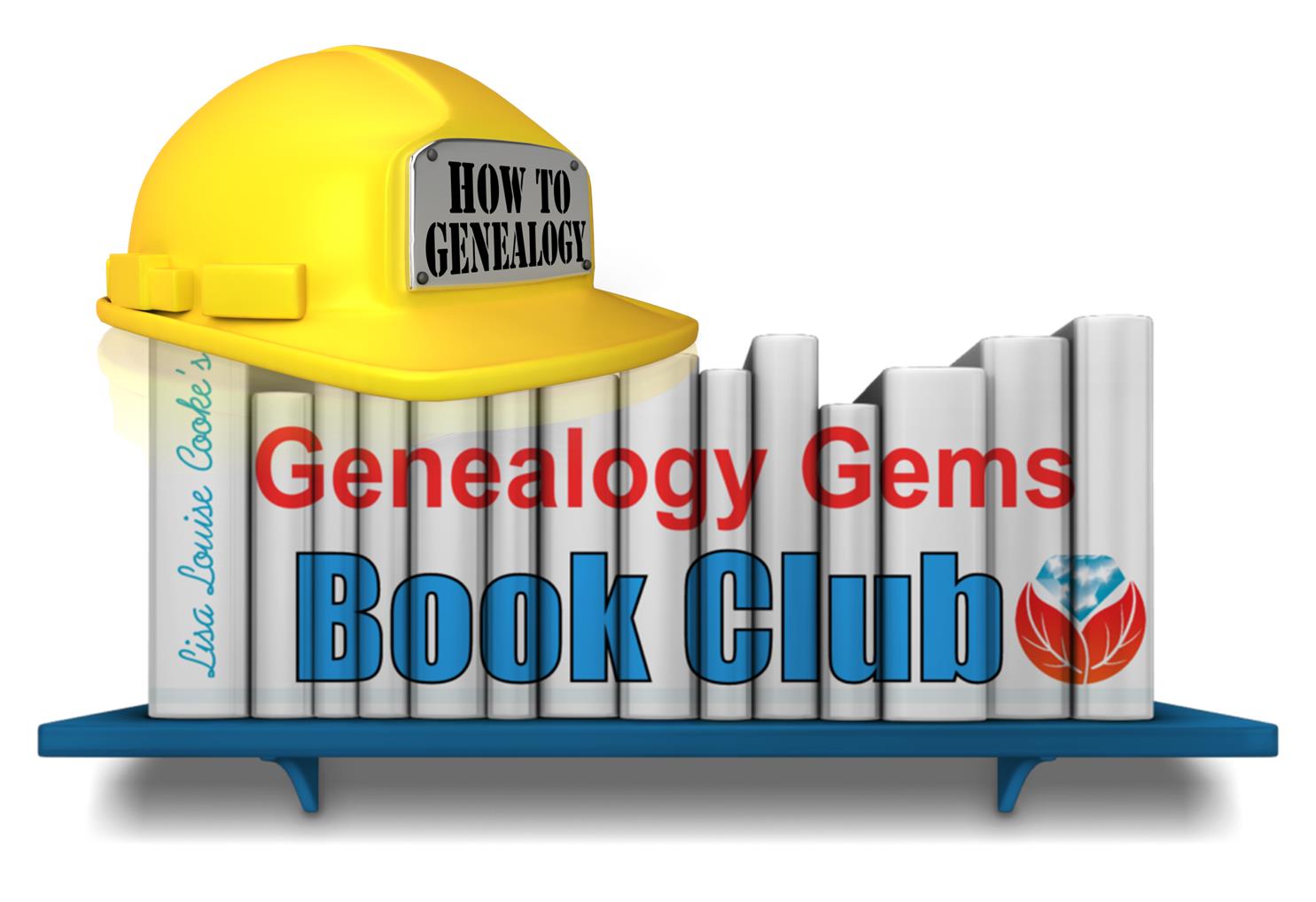 We often mention fantastic how-to genealogy books on the Genealogy Gems podcasts and website. Here we’ve compiled a list of these, a checklist for your own genealogy reference bookshelf.
We often mention fantastic how-to genealogy books on the Genealogy Gems podcasts and website. Here we’ve compiled a list of these, a checklist for your own genealogy reference bookshelf.
(Our favorite pleasure reading picks, fiction and nonfiction, are on The Genealogy Gems Book Club webpage.)
Thank you for purchasing any books through our affiliate links. Your purchases help keep the Genealogy Gems podcast FREE.

 State Census Records
State Census Records by Ann S. Lainhart. It’s got everything you need to know about U.S. censuses taken by states and territories. From this guide, you’ll learn what is available in each state (year by year, often county by county), where it is available and what’s in these records. Though it lacks current online resources for state censuses, once you know about them, you can Google them to find any online records and indexes! Find this book referenced in a blog post about state census records here.
by Ann S. Lainhart. It’s got everything you need to know about U.S. censuses taken by states and territories. From this guide, you’ll learn what is available in each state (year by year, often county by county), where it is available and what’s in these records. Though it lacks current online resources for state censuses, once you know about them, you can Google them to find any online records and indexes! Find this book referenced in a blog post about state census records here.
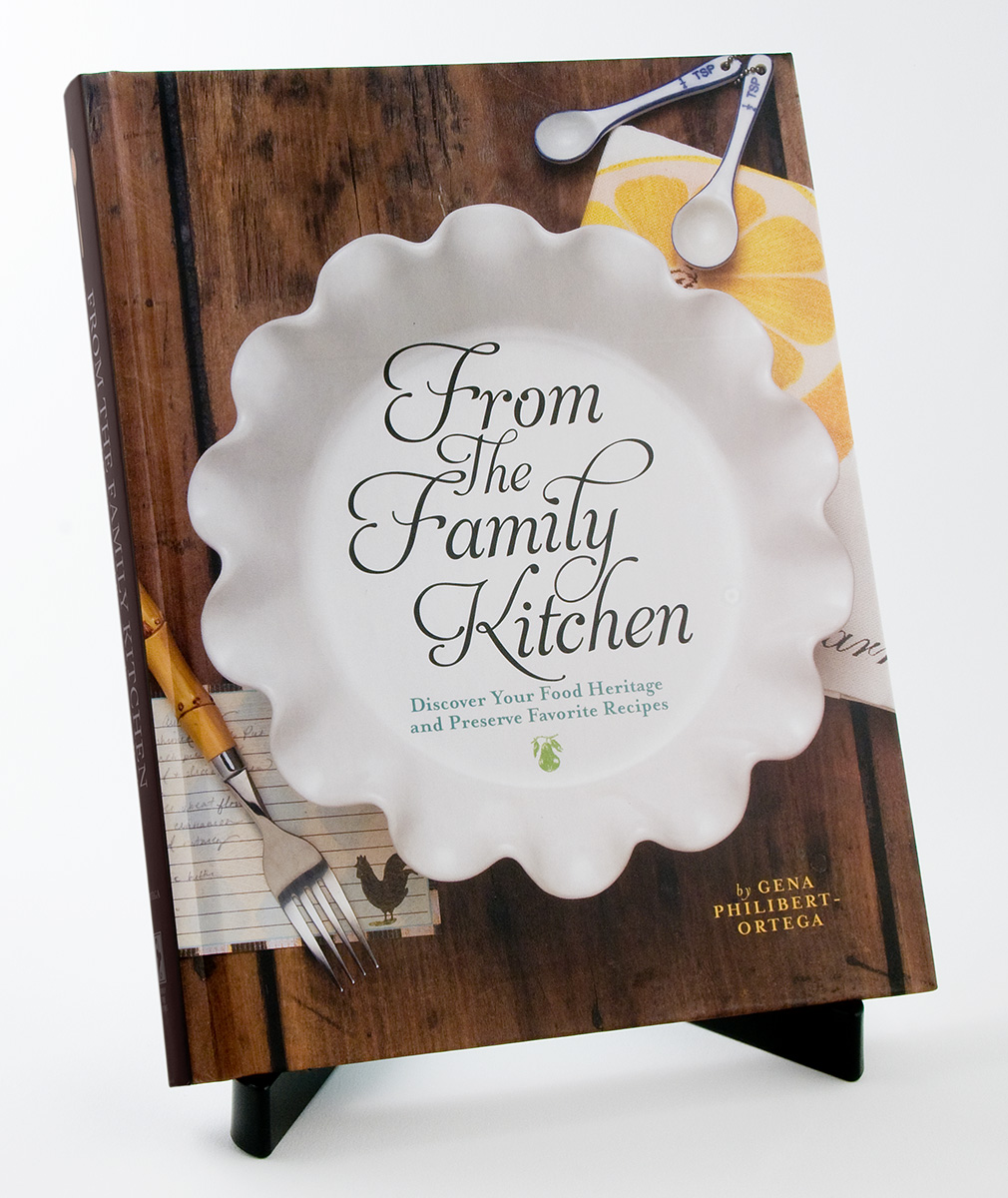
 From the Family Kitchen: Discover Your Food Heritage and Preserve Favorite Recipes
From the Family Kitchen: Discover Your Food Heritage and Preserve Favorite Recipes by Gena Philibert Ortega. Food is an important ingredient in every family’s history! This three-part keepsake recipe journal will help you celebrate your family recipes and record the precious memories those recipes hold. Listen to Lisa’s 2-part conversation with the author in the Genealogy Gems podcast episode 137 and 138. Watch a free video, “Food Family History,” with both of us on the Genealogy Gems YouTube channel.
by Gena Philibert Ortega. Food is an important ingredient in every family’s history! This three-part keepsake recipe journal will help you celebrate your family recipes and record the precious memories those recipes hold. Listen to Lisa’s 2-part conversation with the author in the Genealogy Gems podcast episode 137 and 138. Watch a free video, “Food Family History,” with both of us on the Genealogy Gems YouTube channel.
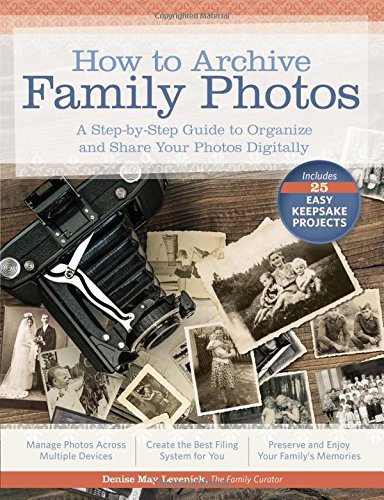 How to Archive Family Photos: A Step-by-Step Guide to Organize and Share Your Photos Digitally
How to Archive Family Photos: A Step-by-Step Guide to Organize and Share Your Photos Digitally by Denise Levenick. The Family Curator’s approach is so practical and forgiving: start where you are. Start small. Take your time. Do a few at a time. Use a consistent and simple file naming and digital file organizing scheme! Click here to listen to Lisa’s interview with her on the free Family Tree Magazine podcast.
by Denise Levenick. The Family Curator’s approach is so practical and forgiving: start where you are. Start small. Take your time. Do a few at a time. Use a consistent and simple file naming and digital file organizing scheme! Click here to listen to Lisa’s interview with her on the free Family Tree Magazine podcast.
 The Library of Congress Illustrated Timeline of the Civil War
The Library of Congress Illustrated Timeline of the Civil War by Margaret E. Wagner quotes vivid first-hand accounts. You’ll read about the smells of war, from baking to bodily functions. You’ll learn about the women behind the scenes whose lives were in constant upheaval and uncertainty. Comments from hospital workers describe the mighty effects of war on the wounded. Intermingled are the stories of free blacks, those being emancipated and black women and men who supported the Union effort as soldiers, nurses and more. It’s a fascinating blend of story and picture, told in a timeline format to help family historians put their ancestors’ experiences in context. For those of us who don’t have firsthand account by our ancestors, these voices help bring to life events and experiences our relatives may have faced. Also available in for the Kindle.
by Margaret E. Wagner quotes vivid first-hand accounts. You’ll read about the smells of war, from baking to bodily functions. You’ll learn about the women behind the scenes whose lives were in constant upheaval and uncertainty. Comments from hospital workers describe the mighty effects of war on the wounded. Intermingled are the stories of free blacks, those being emancipated and black women and men who supported the Union effort as soldiers, nurses and more. It’s a fascinating blend of story and picture, told in a timeline format to help family historians put their ancestors’ experiences in context. For those of us who don’t have firsthand account by our ancestors, these voices help bring to life events and experiences our relatives may have faced. Also available in for the Kindle.
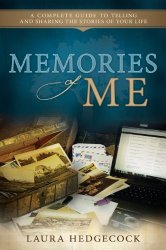
 Memories of Me: A Complete Guide to Telling and Sharing the Stories of Your Life
Memories of Me: A Complete Guide to Telling and Sharing the Stories of Your Life by Laura Hedgecock. This book helps you put the stories of your own past on paper and share them with loved ones. Genealogy Gems Premium members can listen to an interview with the author about the challenges and rewards of writing your life story in Genealogy Gems Premium Podcast episode 116.
by Laura Hedgecock. This book helps you put the stories of your own past on paper and share them with loved ones. Genealogy Gems Premium members can listen to an interview with the author about the challenges and rewards of writing your life story in Genealogy Gems Premium Podcast episode 116.
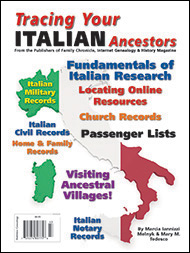 Tracing Your Italian Ancestors by Mary Tedesco. This 84-page guide has two important parts. There’s a section on using U.S. records to learn essentials about your family, and then a section on researching in Italian records. Click here to watch an interview with Mary Tedesco, a host of the popular U.S. television show Genealogy Roadshow.
Tracing Your Italian Ancestors by Mary Tedesco. This 84-page guide has two important parts. There’s a section on using U.S. records to learn essentials about your family, and then a section on researching in Italian records. Click here to watch an interview with Mary Tedesco, a host of the popular U.S. television show Genealogy Roadshow.
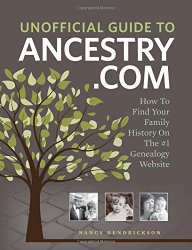 The Unofficial Guide to Ancestry.com: How to Find Your Family History on the No. 1 Genealogy Website
The Unofficial Guide to Ancestry.com: How to Find Your Family History on the No. 1 Genealogy Website by Nancy Hendrickson. Click here to listen to Lisa’s interview with the author on the Family Tree Magazine podcast.
by Nancy Hendrickson. Click here to listen to Lisa’s interview with the author on the Family Tree Magazine podcast.
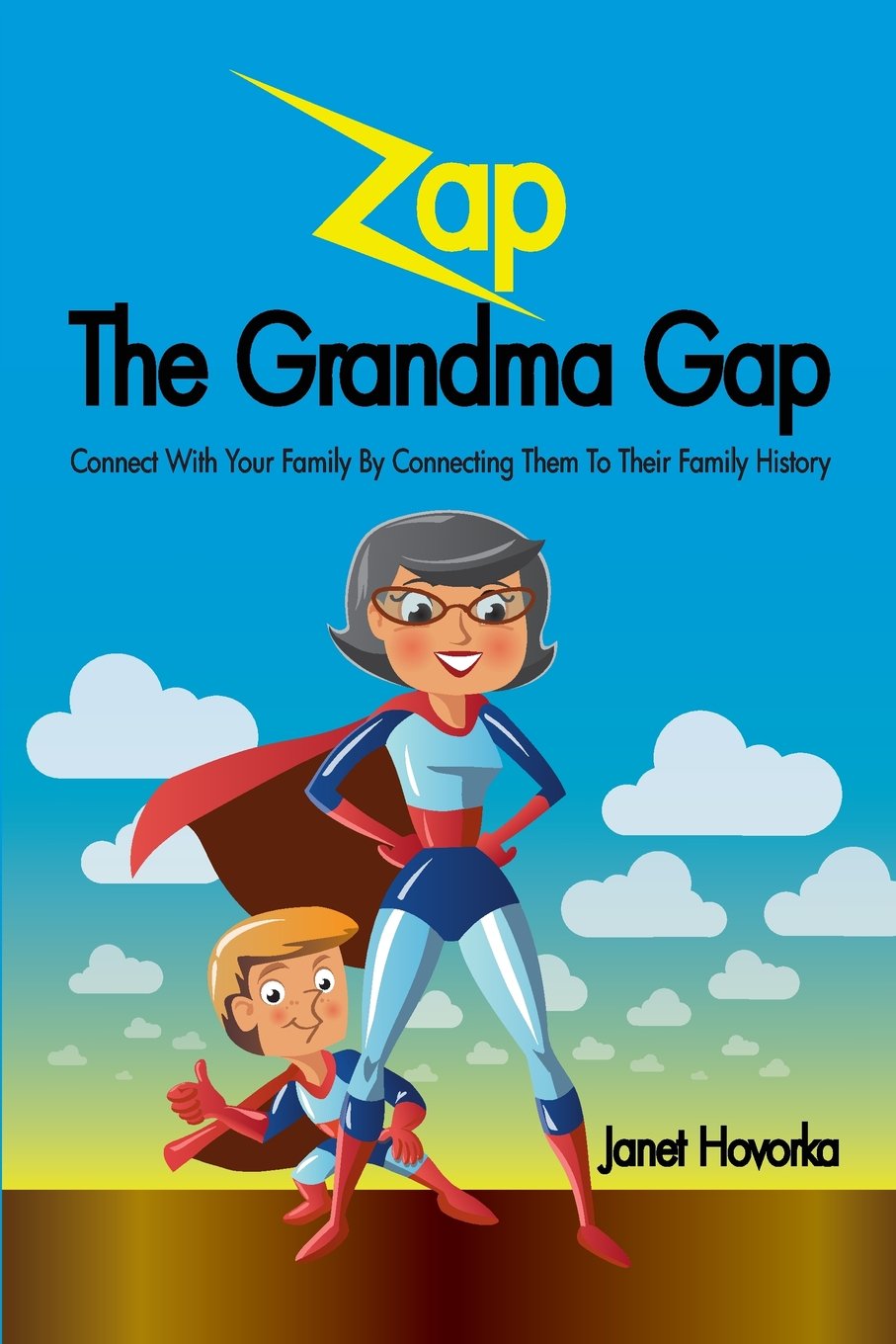 Zap the Grandma Gap: Connect with Your Family by Connecting Them to Their Family History by Janet Hovorka shares tried-and-tested activities for using family history to connect with children and grandchildren. Span the generation gap with these great games and ideas! Meet the author, see more of her kid-friendly family history titles and hear her suggestions in the free Genealogy Gems podcast episode 162.
Zap the Grandma Gap: Connect with Your Family by Connecting Them to Their Family History by Janet Hovorka shares tried-and-tested activities for using family history to connect with children and grandchildren. Span the generation gap with these great games and ideas! Meet the author, see more of her kid-friendly family history titles and hear her suggestions in the free Genealogy Gems podcast episode 162.
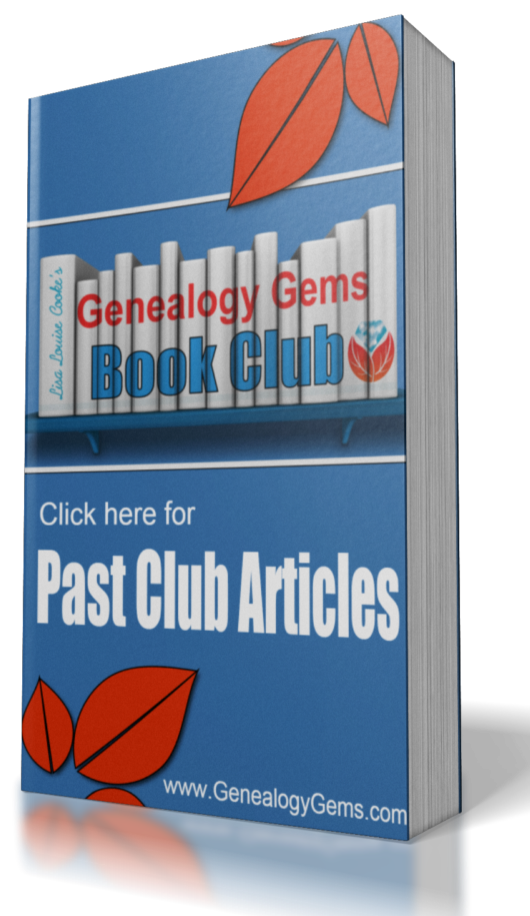 Find more fantastic titles as well as discussion and exclusive author interviews at the The Genealogy Gems Book Club.
Find more fantastic titles as well as discussion and exclusive author interviews at the The Genealogy Gems Book Club.
by Lisa Cooke | Apr 23, 2015 | 01 What's New, Brick Wall, images, Memory Lane, Newspaper, Oral History, Research Skills, United States, YouTube

1950s Fords by Bob P.B. on Flickr Creative Commons. Some rights reserved.
When we try to research our family history from recent decades, we often find privacy barriers: U.S. census records for 1950 and beyond are closed, as are many vital records. Here are some ideas for finding family history in the 1950s and beyond:
1. Interview relatives. The good news is that in many families, there are relatives around who remembers the 1950s. If there’s not, then look to the memories of the next living generation.
Interviewing a relative is one of the most fun and meaningful ways to learn your family history. You can ask specific and personal questions, deepen your relationships with those you interview and gain a better understanding of the lives that led to you. Older people often love to have someone take a sincere interest in them. The free Family History Made Easy podcast episode 2 has a great segment on interviewing your relatives.
2. Read the newspaper. Use newspapers to find obituaries and discover more about daily life, current events, popular opinions of the time, prices for everyday items and more. It’s getting easier than ever to find and search digitized newspapers online, but more recent papers may still be under copyright protection.
Use online resources like to discover what newspapers served your family’s neighborhood, or even whether an ethnic, labor or religious press would have mentioned them. In the US, I always start with the US Newspaper Directory at Chronicling America to search for ALL newspapers published in a particular place and time, as well as the names of libraries or archives that have copies of these papers. Historical societies and local public libraries are also wonderful places to look for newspapers. My book, How to Find Your Family History in Newspapers, teaches readers what to look for in papers and how to locate them online and offline.
3. Search city directories. By the 1950s, most towns and cities published directories of residents, mostly with telephone numbers. I use annual directory listings to track buy generic medication online families from year to year. These might give you your first clue that someone moved, married, separated, divorced or died! I can often find their exact street address (great for mapping!), who lived at the house and sometimes additional information like where they worked, what their job was or who they worked for.
Ancestry.com has over a billion U.S. city directory entries online, up to 1989. But most other online city directory collections aren’t so recent. Look for city directories first in hometown public libraries. Check with larger regional or state libraries and major genealogical libraries.
4. Search for historical video footage. YouTube isn’t just for viral cat videos. Look there for old newsreels, people’s home movies and other vintage footage. It’s not unusual to find films showing the old family neighborhood, a school or community function, or other footage that might be relevant to your relatives.
Use the YouTube search box like you would the regular Google search box. Enter terms like “history,” “old,” “footage,” or “film” along with the names, places or events you hope to find. For example, the name of a parade your relative marched in, a team he played on, a company she worked for, a street he lived on and the like. It’s hit and miss, for sure, but sometimes you can find something very special.
My Contributing Editor Sunny Morton tried this tip. Almost immediately, with a search on the name of her husband’s ancestral hometown and the word “history,” she found a 1937 newsreel with her husband’s great-grandfather driving his fire truck with his celebrity dog! She recognized him from old photos and had read about his dog in the newspapers. (Click here to read her stunned post.) Learn more about searching for old videos in my all-new second edition of The Genealogist’s Google Toolbox, which has a totally updated chapter on YouTube.
Click here to read more about the 1950s U.S. census: when it will be out and how you can work around its privacy restrictions.











 Zap the Grandma Gap: Connect with Your Family by Connecting Them to Their Family History by Janet Hovorka shares tried-and-tested activities for using family history to connect with children and grandchildren. Span the generation gap with these great games and ideas! Meet the author, see more of her kid-friendly family history titles and hear her suggestions in the free
Zap the Grandma Gap: Connect with Your Family by Connecting Them to Their Family History by Janet Hovorka shares tried-and-tested activities for using family history to connect with children and grandchildren. Span the generation gap with these great games and ideas! Meet the author, see more of her kid-friendly family history titles and hear her suggestions in the free  Find more fantastic titles as well as discussion and exclusive author interviews at the
Find more fantastic titles as well as discussion and exclusive author interviews at the 



